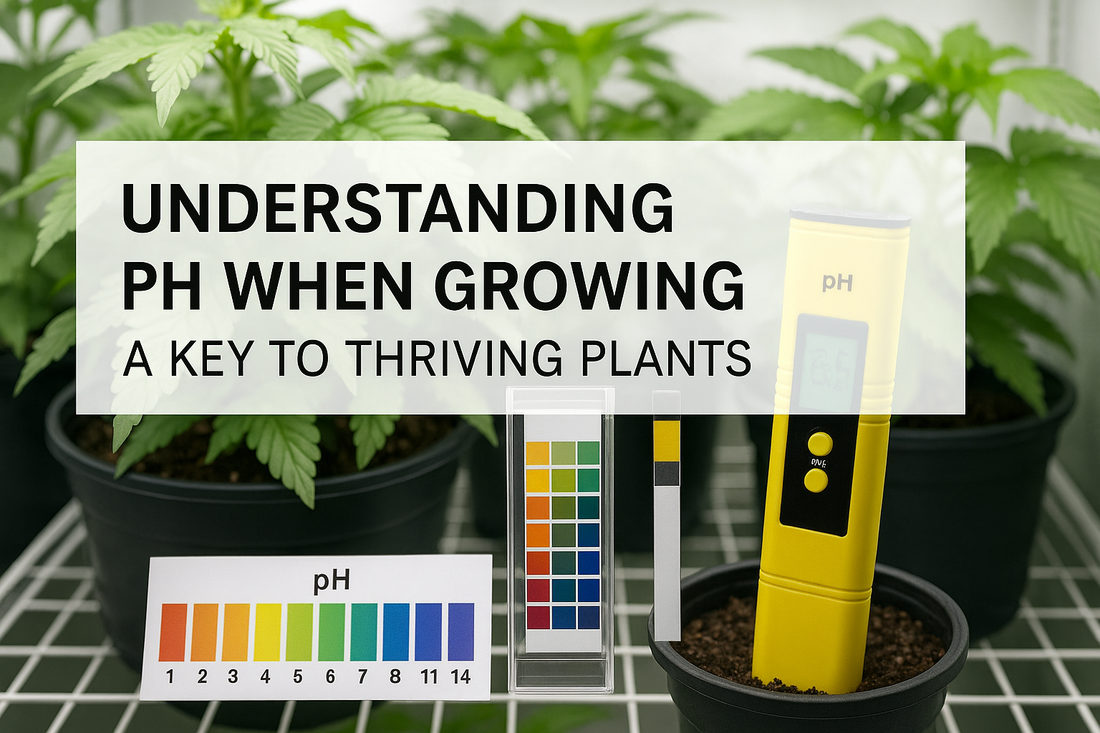
Understanding pH When Growing: A Key to Thriving Plants
In any form of cultivation, whether indoors or outdoors, pH plays a vital role in plant health and productivity. pH refers to the measure of how acidic or alkaline a substance is, with a scale ranging from 0 (most acidic) to 14 (most alkaline). For most plants, particularly in soil and hydroponic systems, maintaining an optimal pH range is essential for nutrient uptake, root health, and overall growth. Let’s dive into what pH is, why it matters in cultivation, and how to maintain it for successful plant growth.
What is pH?
In simple terms, pH measures the concentration of hydrogen ions in a solution, determining its acidity or alkalinity. The pH scale goes from 0 to 14:
- pH 7 is neutral (pure water).
- Below 7 is acidic (vinegar or lemon juice).
- Above 7 is alkaline or basic (baking soda).
For plant growers, pH affects how easily plants can access the nutrients in soil or water. If pH is too far out of the optimal range, plants can experience "nutrient lockout," where nutrients remain in the soil or solution but aren’t absorbed by the plant, leading to deficiencies and reduced yields.
Why is pH Important for Plant Growth?
Each type of plant has an ideal pH range where it can absorb nutrients most effectively. Generally, the best pH for plant growth in soil ranges from 6.0 to 7.0, while hydroponic systems work better in a slightly lower range of 5.5 to 6.5. If pH falls outside these ranges, plants may struggle to take in essential nutrients like nitrogen, phosphorus, and potassium. Here’s how pH levels affect nutrient absorption:
- Low pH (Acidic): Acidic conditions can cause aluminum, iron, and manganese to dissolve in higher amounts, which can be toxic. Simultaneously, it may limit calcium, magnesium, and phosphorus, starving the plant of these nutrients.
- High pH (Alkaline): When the growing medium is too alkaline, nutrients like iron, manganese, and phosphorus become less available, leading to symptoms of deficiency and weakened growth.
Signs of Improper pH in Plants
Understanding pH involves knowing how to detect problems in your plants. Some tell-tale signs of pH imbalance include:
- Yellowing Leaves: Often a sign of nutrient deficiencies, particularly nitrogen and iron.
- Poor Growth: Plants might appear stunted if essential nutrients are inaccessible.
- Leaf Spots or Burnt Tips: Can result from toxicity when certain nutrients dissolve in excess at low pH.
- Wilting or Dropping Leaves: Both high and low pH can stress plants, causing them to wilt or drop leaves prematurely.
Testing and Adjusting pH
To maintain optimal pH levels, regular testing is necessary. Here’s how to do it:
-
Use pH Testing Kits: These are available in various forms, including pH strips, digital pH meters, and liquid test kits. Digital meters are generally more accurate but need regular calibration.
-
Test Water and Growing Medium: Check the pH of your water source and growing medium (soil or hydroponic solution). It’s helpful to test both because water pH can change after coming into contact with soil or nutrient solutions.
-
Adjust as Needed: If pH is off, here’s how you can adjust it:
-
To Increase pH (make more alkaline): For soil Dolomite lime or wood ash can be used.
In water or hydroponics, pH Up Solutions are often used. -
To Decrease pH (make more acidic): For soil, add sulfur or composted organic matter.
In Water or hydroponics, pH Down Solutions are commonly used.
-
To Increase pH (make more alkaline): For soil Dolomite lime or wood ash can be used.
After adjusting pH, allow some time for the medium to stabilize before testing again. Gradual adjustments are best to avoid shocking your plants.
Tips for Maintaining pH Balance
- Use Buffered Nutrients: In hydroponics, using nutrients specifically designed for these systems helps stabilize pH.
- Filter Water Sources: If possible, use filtered or distilled water, as municipal water can contain additives that alter pH.
- Check pH Regularly: Make testing part of your routine. pH levels can fluctuate, especially in hydroponic systems, so monitoring is crucial.
- Invest in Quality pH Meters: Cheap meters can give inaccurate readings. A good-quality meter that is calibrated regularly will help you maintain accurate measurements.
Understanding pH in Soil vs. Hydroponic Systems
Soil and hydroponic systems require different pH management techniques. In soil, organic materials, microbes, and natural compounds create a buffer, stabilizing pH more effectively. In hydroponics, however, pH can fluctuate rapidly as water and nutrient levels change. As a result, hydroponic growers may need to test and adjust pH daily, whereas soil growers might only need weekly checks unless they notice issues.
Conclusion
Maintaining an ideal pH level is essential to a successful grow operation. By ensuring that the pH is within an optimal range, you’ll help your plants access the nutrients they need for healthy growth, reducing the risk of nutrient deficiencies, toxicity, and other stress-related issues. Whether you’re a soil or hydroponic grower, understanding and managing pH is a critical skill that will help you grow healthier, more productive plants.
We stock a wide variety of pH Control Products from pH Meters, pH Monitors and Controllers, pH up and down Solutions, and even Soil pH meters!
Be sure to visit Skyline Grow Shop Instore or visit the Skyline Grow Shops online store today.
So, next time you're preparing your grow space, don’t overlook the importance of pH—get your levels right, and your plants will thrive!
Happy growing!
